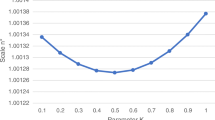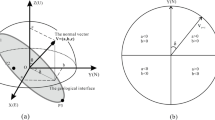Abstract
A linear projection approach is developed to present geoscience research result in planar coordinate system projected from spherical coordinate system. Here, the sphere is intersected by a plane and its surface is projected onto the plane. In order to keep the projected coordinate system orthogonal, and minimize the distortion, one axis of the planar coordinate system is chosen in our projection based on the shape of the region to be projected, and the other axes can be chosen arbitrarily or based on the constraint of the orthogonality. In the new method the projection is self-contained. The forward projection can be fully projected backward without loss of precision. The central area of the sphere will be projected to the planar system without distortion, and the latitudinal length in the rotated spherical system keeps constant during the projecting process. Only the longitudinal length in the rotated spherical system changes with the rotated latitude. The distortion of the projection therefore, overall, is small and suitable for geoscience studies.
Similar content being viewed by others
References Cited
England, P., Molnar, P., 1997. Active Deformation of Asia: From Kinematics to Dynamics. Science, 278(5338): 647–650. doi:10.1126/science.278.5338.647
Flesch, L. M., Haines, A. J., Holt, W. E., 2001. Dynamics of the India-Eurasia Collision Zone. Journal of Geophysical Research, 106(B8):16435. doi:10.1029/2001jb000208
Kirby, J. F., Swain, C. J., 2006. Mapping the Mechanical Anisotropy of the Lithosphere Using a 2D Wavelet Coherence, and Its Application to Australia. Physics of the Earth and Planetary Interiors, 158(2–4): 122–138. doi:10.1016/j.pepi.2006.03.022
Kirby, J. F., Swain, C. J., 2008. An Accuracy Assessment of the Fan Wavelet Coherence Method for Elastic Thickness Estimation. Geochemistry, Geophysics, Geosystems, 9(3):doi:10.1029/2007gc001773
Kirby, J. F., Swain, C. J., 2009. A Reassessment of Spectral Te Estimation in Continental Interiors: The Case of North America. Journal of Geophysical Research, 114(B8):doi:10.1029/2009jb006356
Kong, X., Yin, A., Harrison, T. M., 1997. Evaluating the Role of Preexisting Weaknesses and Topographic Distributions in the Indo-Asian Collision by Use of a Thin-Shell Numerical Model. Geology, 25(6): 527–530. doi:10.1130/0091-7613(1997)025<0527:etropw>2.3.co;2
Ma, H. S., Zheng, Y., Shao, Z. G., et al., 2009. Simulation on Seismogenic Environment of Strong Earthquakes in Sichuan-Yunnan Region, China. Concurrency and Computation: Practice and Experience, 22(12): 1626–1643. doi:10.1002/cpe.1518
Meade, B. J., 2007. Present-Day Kinematics at the India-Asia Collision Zone. Geology, 35(1):81. doi:10.1130/g22924a.1
Royden, L. H., 1997. Surface Deformation and Lower Crustal Flow in Eastern Tibet. Science, 276(5313): 788–790. doi:10.1126/science.276.5313.788
Snyder, J. P., 1987. Map Projections—A Working Manual. U.S. Geological Survey Professional Paper 1395, Washington D.C.
Swain, C. J., Kirby, J. F., 2006. An Effective Elastic Thickness Map of Australia from Wavelet Transforms of Gravity and Topography Using Forsyth’s Method. Geophysical Research Letters, 33(2):L02314. doi:10.1029/2005gl025090
Zheng, Y., Xiong, X., Chen, Y., et al., 2011. Effects of Fault Movement and Material Properties on Deformation and Stress Fields of Tibetan Plateau. Earthquake Science, 24(2): 185–197. doi:10.1007/s11589-011-0783-5
Zheng, Y., Chen, Y., Fu, R. S., et al., 2007. Simulation of the Effects of Faults Movement on Stress and Deformation Fields of Tibetan Plateau by Discontinuous Movement Models. Chinese J. Geophys., 50(5): 1398–1408 (in Chinese with English Abstract)
Zheng, Y., Fu, R. S., Xiong, X., 2006. Dynamic Simulation of Lithospheric Evolution from the Modern China Mainland and Its Surrounding Areas. Chinese J. Geophys., 49(2): 415–427 (in Chinese with English Abstract)
Author information
Authors and Affiliations
Corresponding author
Additional information
Zheng, Y., Jin, B. K., Xiong, X., et al., 2015. An Adaptive 2D Planar Projection and Its Application in Geoscience Studies. Journal of Earth Science, 26(5): 724–728. doi:10.1007/s12583-015-0591-2. http://en.earth-science.net
Rights and permissions
About this article
Cite this article
Zheng, Y., Jin, B., Xiong, X. et al. An Adaptive 2D Planar Projection and Its Application in Geoscience Studies. J. Earth Sci. 26, 724–728 (2015). https://doi.org/10.1007/s12583-015-0591-2
Received:
Accepted:
Published:
Issue Date:
DOI: https://doi.org/10.1007/s12583-015-0591-2




